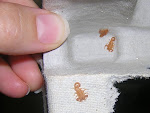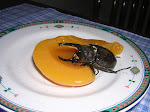 Uroctonus mordax, a light morph. Humboldt County, CA. June 2009.
Uroctonus mordax, a light morph. Humboldt County, CA. June 2009. Thanks to Dr. P hillip Brownell, Oregon State University Zoology Dept., for photo ID.
This scorpion was under a large, loose piece of Redwood bark about 30 mi. south of Eureka, CA. I found her at the end of a long hike in which I had flipped bark piece after piece, rolled rocks, dug under litter, etc., in search of any of the dozen or so native (and elusive!) PacNW scorpions. The prize log lay on the edge of an old haul road, about 12' feet away, and I eyed it there for some while deciding whether my blistered feet and disappointed spirit could stomach one more fruitless flip. A pointless contemplation! I can never pass up a flip! She was under a large piece of bark laying loosely on top of the Redwood, no prying required. I lifted it and bingo! This most beautiful critter:
Gorgeous!!
My whoops and hollers could be heard throughout the woods, a few excited expletives laced in. My friends came running, but when they saw the source of my excitement their reaction was considerably less...enthusiastic. Who cares?! My whoops continued. It was a great moment!
According to Dr. Phillip Brownell, who studies neurobiology at Oregon State University using arachnids, this individual scorpion is a "light morph"; U. mordax is typically darker. Her lighter appearance may due in part to her stretched abdomen. Notice how the pleural membrane -- the lighter, stretchy section between abdomenal segments -- is really noticeable, especially from the sides? She either has a very full belly, or (I think) she is gravid ("pregnant").
Most of you reading this have two questions at this point: 1) where do these occur? and 2) is it poisonous? U. mordax occurs in a variety of habitats throughout the PacNW, from under large rocks on gravelly slopes to the more moist and prey-rich habitat of under-bark on decaying logs, among others. "Under" is the key word. For the most part, you'll have to lift, flip, and dig for scorpions in this region, and just plain get lucky (as I did). They do have venom, as do most arachnids, but it isn't going to kill you or send you to an emergency room unless you have some kind of rare allergic reaction. The scorpion with the most potent venom in the U.S. includes species in the Centruroides genus, and you'll find them only in the Southwest. I'm not an expert on U. mordax or other scorpions of the PacNW. My knowledge of them is limited, I'm learning as I go. But I can say this: during several years of handling the more toxic Southwest genera of scorpions on a daily basis, I was NEVER stung. In other words: don't worry about U. mordax!
This and other PacNW scorpions are overlooked, shy creatures. Don't go running from your home or change your daily activities now that you know they exist in this region. If you've never encountered one, you likely never will. And if you ever do, take a moment to enjoy it because it may well be your last.
General info. on scorpions:
I've posted on scorpions here and here. If you want more information, perhaps check out:
The VenomList (U. mordax pictures, information, links)
National Geographic
Bug Guide
Blog post of a PacNW scorpion encounter
UC Davis (addresses desert SW scorpions, not those found in the PacNW)

+reduced.jpg)

